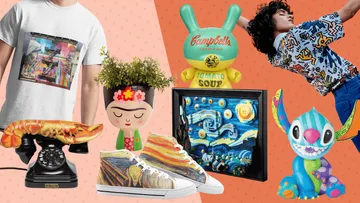In the big world of licensing the highly marketed movies, TV shows, characters, athletes and video games tend to take up a lot of room. However a lot of people are also buying licensed products, often without knowing it. Licensed art is used across a number of categories from homewares and health and beauty to stationery and paper to apparel and accessories. From big names like Salvador Dali and Keith Harring to a huge range of lesser known artists covering all styles and genres.
Manufacturers and retailers are waking up to the fandoms around artists. The rise of social media has made it easier for artists to build up communities and for fans to discover new and interesting artists.
There are a growing number of high profile licensed deals in the art sector that are helping demonstrate the power of art in this space.
The LEGO Group recently announced the LEGO Art Vincent van Gogh – “Sunflowers” set, created in collaboration with the Van Gogh Museum in Amsterdam. The 2,615-piece set reimagines Van Gogh’s 1889 painting as a three-dimensional LEGO artwork, even emphasizing the artist’s signature brushstrokes, use of light and shadow and vibrant yellow hues.
ARTiSTORY, a leading innovator in art-inspired merchandise and experiences, announced its collaboration with Tate, which includes the art museums, Tate Modern, Tate Britain, Tate St. Ives and Tate Liverpool. This partnership will enable ARTiSTORY’s licensees to access a wide range of artworks from Tate’s collections. By leveraging the rich heritage and iconic artworks of Tate, ARTiSTORY is aiming to inspire creativity and foster a deeper appreciation for art through thoughtfully designed products and experiences.
The Van Gogh Museum in Amsterdam recently entered a notable licensing collaboration with Jeep in China. This partnership is just part of the museum’s broader strategy to expand its brand and make Vincent van Gogh’s art accessible to diverse audiences globally.
The museum houses some 200 paintings, 500 drawings, 30 prints and more than 800 letters, owned by the Vincent van Gogh Foundation. In 2023 the museum celebrated its 50th anniversary with numerous collaborations including Floral Street, LOQI, BeddingHouse, BE@RBRICK, CARIUMA, WonderFold, Shoe Palace, Secrid, Just Dutch as well as Pokémon.
For artists who aren’t as well known as Van Gogh, licensing their art enables them to fill in the gaps when art sales are at a low or in a seasonal slump. Licensing is a continual, residual income builder and can be very lucrative if they learn what it is that manufacturers and retailers are likely looking for.
Manufacturers and retailers are looking for themes that they can use across a range of products, with complementary images. So no matter what type or style of design, it’s important that art is created in sets. This may seem very commercial, but designers that can offer sets of 4, 5 or 10 in a collection of themes, are likely to be more appealing to manufacturers as they can make more products or sets with it.
Patterns are also incredibly versatile for product development. Patterns and designs that complement original art images will work incredibly well for home, bedding and fabric manufacturers.
A perfect example of the power of patterns to drive products is Cath Kidston. Kidston, a British fashion designer, who sold home furnishings and related goods and is particularly known for her nostalgic floral patterns. The brand is now owned by Next Plc the British multinational clothing, footwear and home products retailer.
Over the 20 years since its founding Kidston has collaborated with other brands and categories. With outdoor clothing and equipment store Millets to design tents (2005–6), Nokia and Carphone Warehouse on mobile phones (2006), and Roberts digital radios (2005 onwards). In 2008, a collaboration with Tesco to produce shopping bags made from plastic bottles raised almost £500,000 for Marie Curie Cancer Care and saved about six million plastic bottles from landfill.
Many designers are creating characters and cartoons and these too are proving very popular with manufacturers. Again social media is a great tool for characters and artists to get their art well known and make them attractive for commercialisation. A great example of this is Ketnipz. Created in 2016 by then teenager Harry Hambley from Cardiff, UK, his cartoon Ketnipz - which features a "bean" character and his amusing musings on life now has over 3.6 million followers on Instagram and nearly 250k followers on YouTube and has collaborated with Instagram itself on digital stickers and CASETiFY as well as having branded online stores. Ketnipz also has global appeal with huge followings in Asia and North America.
So from famous artists, to pattern designers and cartoonists there are huge opportunities for designers in the licensing space. And for manufacturers there is a vast array of different designers to collaborate with, many with their already built in communities and fandoms.
